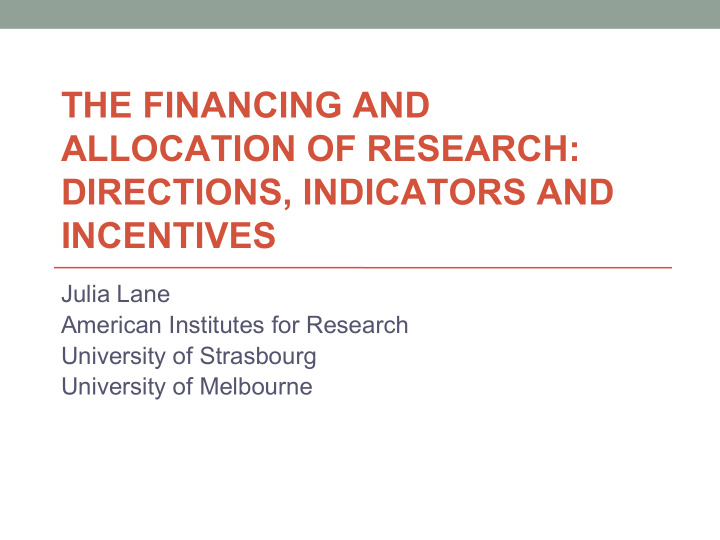



THE FINANCING AND ALLOCATION OF RESEARCH: DIRECTIONS, INDICATORS AND INCENTIVES Julia Lane American Institutes for Research University of Strasbourg University of Melbourne
Overview • Motivation • Conceptual Framework • Empirical Framework • Directions, Indications and Incentives • Next steps
Overview • Motivation • Conceptual Framework • Empirical Framework • Directions, Indications and Incentives • Next steps
Key questions How much should a nation spend on science? What kind of science? How much from private versus public sectors? Does demand for funding by potential science performers imply a shortage of funding or a surfeit of performers?......A new “science of science policy” is emerging, and it may offer more compelling guidance for policy decisions and for more credible advocacy
We spend a lot
Note… t he data don’t exist
An Opportunity . . . STAR METRICS represents a valuable step toward developing detailed, broadly accessible and nationally representative data that would allow systematic and scientific analysis of the organization, productivity, and at least some of the effects of federally funded research [but] . . 1. . . . STAR METRICS data are largely inacessible . . . 2. . . . data collection could usefully be expanded to include more universities and other performers . . . 3. . . . STAR METRICS data would be more useful if steps were taken to ensure the data can be flexibly linked to other data sources [such as] those maintained by the federal statistical and science agencies . . . as well as P. 4-10 proprietary data sources . . . Creating a robust and linkable dataset may require the addition of individual and organizational identifiers.
Overview • Motivation • Conceptual Framework • Empirical Framework • Directions, Indications and Incentives • Next steps
Major use: Evaluation • What is the impact or causal effect of a program on outcome of interest? • Is a given program effective compared to the absence of the program? • When a program can be implemented in several ways, which one is the most effective?
A conceptual framework
Core outcome is ideas • Goal of project/firm: to create and transmit scientific ideas and push for their adoption (by other scientists, policy-makers or businesses) • Behavioral Framework; Ideas are transmitted by workers in a variety of potentially measurable ways, and emails • Behavioral Framework: Social networks/collaboration are a major vehicle whereby ideas are transmitted
A Conceptual Framework (1) = Y it (2) α + X it (1) λ + ε it (1) Y it (2) = Z it β +X it (2) μ + η it , (2) Y it Y (1) output variables Y (2) team composition variables Both are determined by a set of control variables X (1) and X (2) that can overlap and be truly exogenous or predetermined, A variable of key interest in Z is funding investment.
Overview • Motivation • Conceptual Framework • Empirical Framework • Directions, Indications and Incentives • Next steps
The Empirical Framework Source: Ian Foster, University of Chicago
Example of input
STAR Institution STAR Pilot Agency Budget Project Award Acquisition Agency And Analysis Record Direct Award Benefit Analysis State Endowment Institution Funding Funding Papers Intellectual Research Property Financial System Project Benefit Disbursement Analysis Patents Innovation Start-Up Analysis Procurement Subcontracting HR System System System Jobs, Personnel Vendor Contractor Purchases, Contracts Benefit Analysis Hire Buy Engage Detailed Existing Characterization Institutional and Reporting Summary Download State
18 Example of Output – Census Data • Business Register (BR) • Universe of U.S. non-agricultural businesses and the source of data from which all other economic data are ultimately created • Key data provided: industry classification, geographic data, employment measures • Longitudinal Business Database (LBD) • Universe of employer businesses, unique establishments, the LBD covers all industries and all U.S. States • Key data provided: industry classification, geographic data, employment measures, payroll, firm age • Integrated Longitudinal Business Database (iLBD) • Universe of non-employer businesses with links to employer universe • iLBD records are identified by either PIKs or EINS • Key data provided: industry classification, gross receipts, geographic data
Overview • Motivation • Conceptual Framework • Empirical Framework • Directions, Indications and Incentives • Next steps
20 Directions: Some Initial Results Joint Frequency of NAICS and Last Occupation at CalTech • Majority of Caltech Employees are Graduates and Post Graduates who start Consulting companies
21 Directions: Some Initial Results Map of where Caltech employees go by State • Most Caltech employees end up staying in California
22 Directions: Some Initial Results Caltech employees are concentrated in the Los Angeles/Southern California area and around San Francisco
Indicators: Aggregate information
Indicators: Visualizations
Incentives ➢ People focus => more focus on students ➢ Reduced Burden => more time on research ➢ University led => replicable and generalizable ➢ 38 researchers have worked with Umetrics data ➢ Research based => evolving field ➢ Science Policy Forum, Research Policy R&R ➢ Economic Reports, Senate Appropriations Testimony, Press coverage ➢ 60 Participants in A2 Workshop
Overview • Motivation • Conceptual Framework • Empirical Framework • Directions, Indications and Incentives • Next steps
Institute for Research on Innovation and Science • Federated organization (Core & Nodes) yield: • Quick startup that leverages existing resources • Synergies at the core facility (Michigan) • Expertise, Outreach and Data (AIR/CIC, OSU, CENSUS) • Potential to expand the above (Illinois, GA Tech, UMass) • Stakeholder partnerships yield: • Use inspired questions (e.g. CIC VPRs) • Data and financial support (CIC, AAU, APLU)
Engage with Federal agencies
Engage Internationally inca.preprod.disko.fr
Engage internationally
And a reminder of why How much should a nation spend on science? What kind of science? How much from private versus public sectors? Does demand for funding by potential science performers imply a shortage of funding or a surfeit of performers?......A new “science of science policy” is emerging, and it may offer more compelling guidance for policy decisions and for more credible advocacy
Recommend
More recommend